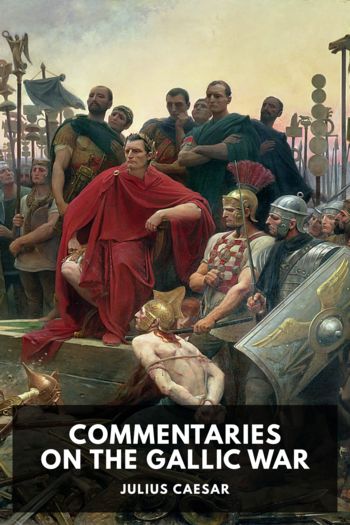Fateful Lightning: A New History of the Civil War & Reconstruction by Allen Guelzo (icecream ebook reader txt) 📗

- Author: Allen Guelzo
Book online «Fateful Lightning: A New History of the Civil War & Reconstruction by Allen Guelzo (icecream ebook reader txt) 📗». Author Allen Guelzo
As late as the 1830s, the United States of America looked and behaved more like a league or a compact of states than a single country, and its Constitution was still regarded as something of an experiment, embraced mostly for its practicality. “Asking a State to surrender a part of her sovereignty is like asking a lady to surrender part of her chastity,” declared the eccentric Virginia politician John Randolph of Roanoke, who even on the floor of Congress made his loyalties clear by insisting that “when I speak of my country, I mean the Commonwealth of Virginia.” The English travel writer George Featherstonhaugh was confounded to hear a South Carolinian declare: “If you ask me if I am an American, my answer is, No, sir, I am a South Carolinian.” The framers of the Constitution, fearing the possibility that state antagonisms, economic competition, and political corruption would easily derail the national system, appealed to the spirit of union or the virtue of political compromise to defuse the threat of divisive issues, but did not appeal to some elusive national authority.6
This is not to say, though, that Americans were not becoming a nation in other ways. No matter how jealously the states regarded and defended their individual political privileges and identities, it would have been hard for a people who spoke the same language, read the same books, heard the same music, and voted in the same elections not to develop some sort of fellow-feeling, irrespective of state boundaries. This was especially true for those Americans who had actually borne the brunt of the fighting in the Revolutionary War, and who carried out of the Revolution a highly different perspective on the unity of the American republic. In the snows of Valley Forge and in the heat of the Carolinas, in victory and in defeat, soldiers from Virginia, Massachusetts, Pennsylvania, and all the other states had undergone so many hardships together that their different backgrounds faded to unimportance.
One of these soldiers, John Marshall, began the Revolution as a Virginia militiaman, then enlisted in the Continental army, and endured the army’s winter at Valley Forge. He remembered later, “I was confirmed in the habit of considering America as my country and Congress as my government,” not Virginia.7 And Marshall would later rise, as chief justice of the Supreme Court, to shape a system of national jurisprudence that transcended state boundaries and loyalties. A South Carolinian (turned Tennessean) named Andrew Jackson lost two brothers and his mother to the Revolution. Captured by the British, he refused a British officer’s order to clean the officer’s boots and was rewarded with a blow from the officer’s sword. It left a scar Jackson carried with him for the rest of his life, and it also left a burning hatred of all enemies of his country, whether they were British invaders or (as it turned out later) fellow Southerners trying to nullify congressional legislation.8
By the end of the 1830s, the Union, crisscrossed by “mystic chords of memory,” had ascended to the level of a national faith. The belligerent Tennessee parson and newspaper editor William G. Brownlow attacked the notion that the Constitution was merely a temporary political umbrella put up by the individual states to protect their state interests. “The Constitution,” insisted Brownlow, was the political creation of the American people as a single nation, and it “was formed by the people to govern the people, and no single individual State was called upon as a separate ‘sovereignty’ to sign or ratify that Constitution.” Alexander Stephens, who one day would serve as the vice president of the Confederate States, said that for Abraham Lincoln the Union “rose to the sublimity of a religious mysticism,” and even a perfectly straightforward politician such as William H. Bissell of Illinois felt no embarrassment in claiming that whenever anyone in the West carelessly broached the idea of “destroying this Union,” there would not be “a man throughout that vast region who will not raise his hand and swear by the Eternal God, as I do now, that it shall never be done, if our arms can save it.” When, as it turned out, other members of the Union did just that and asked the Lincolns and Bissells to choose between state or local interests and the Union, the answer would more and more be the Union.9
The experience of the Revolution and the development of political maturity were only the first steps away from disunity and suspicion. The new political generation of Americans in the 1830s found two other important cultural paths by which to rise above their divisions. One of these was the embrace of a common religion. Although the Constitution forbade Congress from singling out any particular religion or religious denomination as a national “established” church, it was nevertheless clear that Americans in all parts of the country overwhelmingly favored Protestant, evangelical Christianity. The overall number of Christian congregations rose from 2,500 in 1780 to 52,000 in 1860. Along with the new congregations came new publication agencies, such as the American Bible Society and American Tract Society, which spun off a million Bibles and 6 million religious books and pamphlets each year, and a constellation of inter-locked social reform and missionary agencies. Evangelical Protestant churches claimed approximately 15 percent of the American population as full members, and as much as 40 percent of all Americans as “attenders” or “hearers.”10 There were many differences between various groups of evangelical Protestants, and they organized themselves into more separate and subdivided denominations—Presbyterians, Baptists, Methodists, Congregationalists, and so on—than there were states. But one thing they had in common was





Comments (0)